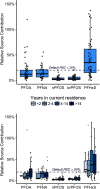Tap Water Contributions to Plasma Concentrations of Poly- and Perfluoroalkyl Substances (PFAS) in a Nationwide Prospective Cohort of U.S. Women
- PMID: 31170009
- PMCID: PMC6792361
- DOI: 10.1289/EHP4093
Tap Water Contributions to Plasma Concentrations of Poly- and Perfluoroalkyl Substances (PFAS) in a Nationwide Prospective Cohort of U.S. Women
Abstract
Background: Between 2013 and 2015, concentrations of poly- and perfluoroalkyl substances (PFAS) in public drinking water supplies serving at least six million individuals exceeded the level set forth in the health advisory established by the U.S. Environmental Protection Agency. Other than data reported for contaminated sites, no systematic or prospective data exist on the relative source contribution (RSC) of drinking water to human PFAS exposures.
Objectives: This study estimates the RSC of tap water to overall PFAS exposure among members of the general U.S.
Methods: We measured concentrations of 15 PFAS in home tap water samples collected in 1989-1990 from 225 participants in a nationwide prospective cohort of U.S. women: the Nurses' Health Study (NHS). We used a one-compartment toxicokinetic model to estimate plasma concentrations corresponding to tap water intake of PFAS. We compared modeled results with measured plasma PFAS concentrations among a subset of 110 NHS participants.
Results: Tap water perfluorooctanoic acid (PFOA) and perfluorononanoic acid (PFNA) were statistically significant predictors of plasma concentrations among individuals who consumed [Formula: see text] cups of tap water per day. Modeled median contributions of tap water to measured plasma concentrations were: PFOA 12% (95% probability interval 11%-14%), PFNA 13% (8.7%-21%), linear perfluorooctanesulfonic acid (nPFOS) 2.2% (2.0%-2.5%), branched perfluorooctanesulfonic acid (brPFOS) 3.0% (2.5%-3.2%), and perfluorohexanesulfonic acid (PFHxS) 34% (29%-39%). In five locations, comparisons of PFASs in community tap water collected in the period 2013-2016 with samples from 1989-1990 indicated increases in quantifiable PFAS and extractable organic fluorine (a proxy for unquantified PFAS).
Conclusions: Our results for 1989-1990 compare well with the default RSC of 20% used in risk assessments for legacy PFAS by many agencies. Future evaluation of drinking water exposures should incorporate emerging PFAS. https://doi.org/10.1289/EHP4093.
Figures




References
-
- Barzen-Hanson KA, Roberts SC, Choyke S, Oetjen K, McAlees A, Riddell N, et al. . 2017. Discovery of 40 classes of per- and polyfluoroalkyl substances in historical aqueous film-forming foams (AFFFs) and AFFF-impacted groundwater. Environ Sci Technol 51(4):2047–2057, PMID: 28098989, 10.1021/acs.est.6b05843. - DOI - PubMed
-
- Belanger CF, Hennekens CH, Rosner B, Speizer FE. 1978. The Nurses' Health Study. Am J Nurs 78(6):1039–1040, PMID: 248266. - PubMed
-
- Calafat AM, Kuklenyik Z, Reidy JA, Caudill SP, Tully JS, Needham LL. 2007. Serum concentrations of 11 polyfluoroalkyl compounds in the U.S. population: data from the National Health and Nutrition Examination Survey (NHANES). Environ Sci Technol 41(7):2237–2242, PMID: 17438769. - PubMed
-
- Dassuncao C, Hu XC, Nielsen F, Weihe P, Grandjean P, Sunderland EM. 2018. Shifting global exposures to poly- and perfluoroalkyl substances (PFASs) evident in longitudinal birth cohorts from a seafood-consuming population. Environ Sci Technol 52(6):3738–3747, PMID: 29516726, 10.1021/acs.est.7b06044. - DOI - PMC - PubMed
Publication types
MeSH terms
Substances
Grants and funding
LinkOut - more resources
Full Text Sources
Medical
Miscellaneous

